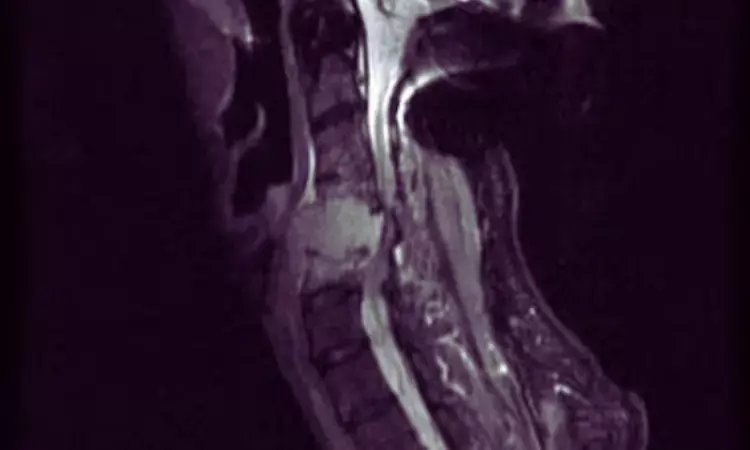- Home
- Medical news & Guidelines
- Anesthesiology
- Cardiology and CTVS
- Critical Care
- Dentistry
- Dermatology
- Diabetes and Endocrinology
- ENT
- Gastroenterology
- Medicine
- Nephrology
- Neurology
- Obstretics-Gynaecology
- Oncology
- Ophthalmology
- Orthopaedics
- Pediatrics-Neonatology
- Psychiatry
- Pulmonology
- Radiology
- Surgery
- Urology
- Laboratory Medicine
- Diet
- Nursing
- Paramedical
- Physiotherapy
- Health news
- Fact Check
- Bone Health Fact Check
- Brain Health Fact Check
- Cancer Related Fact Check
- Child Care Fact Check
- Dental and oral health fact check
- Diabetes and metabolic health fact check
- Diet and Nutrition Fact Check
- Eye and ENT Care Fact Check
- Fitness fact check
- Gut health fact check
- Heart health fact check
- Kidney health fact check
- Medical education fact check
- Men's health fact check
- Respiratory fact check
- Skin and hair care fact check
- Vaccine and Immunization fact check
- Women's health fact check
- AYUSH
- State News
- Andaman and Nicobar Islands
- Andhra Pradesh
- Arunachal Pradesh
- Assam
- Bihar
- Chandigarh
- Chattisgarh
- Dadra and Nagar Haveli
- Daman and Diu
- Delhi
- Goa
- Gujarat
- Haryana
- Himachal Pradesh
- Jammu & Kashmir
- Jharkhand
- Karnataka
- Kerala
- Ladakh
- Lakshadweep
- Madhya Pradesh
- Maharashtra
- Manipur
- Meghalaya
- Mizoram
- Nagaland
- Odisha
- Puducherry
- Punjab
- Rajasthan
- Sikkim
- Tamil Nadu
- Telangana
- Tripura
- Uttar Pradesh
- Uttrakhand
- West Bengal
- Medical Education
- Industry
PET/CT technique revolutionizes spinal bone metastases detection in pheochromocytoma and paraganglioma: Study

USA: Gallium-68 (Ga-68) DOTATATE PET/CT should be the modality of choice in pheochromocytoma/paraganglioma (PPGL)-related spinal bone metastases due to its superior detection rate, a recent study published in European Radiology has shown.
The groundbreaking study has unveiled the diagnostic prowess of advanced imaging modalities in detecting spinal bone metastases associated with pheochromocytoma and paraganglioma. The research represents a significant leap forward in the early identification and management of metastatic disease in these rare neuroendocrine tumors.
"Ga-68 DOTATATE PET/CT appears to be the best approach for detecting spinal bone metastases in patients with certain neuroendocrine tumors," the researchers stated. Bone metastases destroy and weaken skeletal tissue and predispose cancer patients to acute and chronic skeletal-related events (SREs).
In a study of patients with pheochromocytomas and paragangliomas, the group found the approach was superior to F-18 FDG-PET/CT, MRI of the spine, whole-body MRI, and whole-body CT. The finding is significant regarding efforts to prevent severe complications in these patients.
Bone metastases are frequently observed in patients with solid tumors; observed in up to 71% of metastatic PPGL patients. SREs such as spinal cord compression, bone pain, and fractures not only affect mortality and morbidity rates in these individuals but also increase medical costs. However, there is limited data from head-to-head comparisons among imaging techniques for detecting bone metastases in these patients.
To fill this knowledge gap, Karel Pacak, National Institutes of Health, Bethesda, MD, USA, and colleagues aimed to compare the diagnostic performance of [68Ga]DOTATATE PET/CT, [18F]FDG PET/CT, MRI of the spine, and whole-body MRI and CT for detecting PPGL–related spinal bone metastases.
PPGL participants with spinal bone metastases prospectively underwent [68Ga]DOTATATE PET/CT, [18F]FDG PET/CT, contrast-enhanced MRI of the neck and thoracic-abdominopelvic regions (MRIWB), MRI of the cervical-thoracolumbar spine (MRIspine), and contrast-enhanced CT of the neck and thoracic-abdominopelvic regions (CTWB) between 2014 and 2020. They calculated per-lesion and per-patient detection rates.
Counting of spinal bone metastases was limited to a maximum of one lesion per vertebrae. A composite of all anatomic and functional imaging served as an imaging comparator. Detection rates between the scans were compared using the McNemar test.
The following were the key findings of the study:
· Forty-three consecutive participants (mean age, 41.7 ± 15.7 years; females, 22) with MRIspine were included who also underwent [68Ga]DOTATATE PET/CT (n = 43), [18F]FDG PET/CT (n = 43), MRIWB (n = 24), and CTWB (n = 33).
· Forty-one of 43 participants were positive for spinal bone metastases, with 382 lesions on the imaging comparator.
· [68Ga]DOTATATE PET/CT demonstrated a per-lesion detection rate of 98.7%, which was superior compared to MRIspine (80.6%), [18F]FDG (72.0%), MRIWB (55.3%), and CTWB (44.8%).
· The per-patient detection rate of [68Ga]DOTATATE PET/CT was 100%, which was higher compared to [18F]FDG PET/CT (90.2%), MRIspine (97.6%), MRIWB (95.7%), and CTWB (81.8%).
In conclusion, [68Ga]DOTATATE PET/CT demonstrated superiority in spinal bone metastase detection compared to [18F]FDG PET/CT, MRIspine, CTWB, and MRIWB indicating that it should be the imaging modality of choice when looking for metastatic spine disease associated with PPGL.
It is more sensitive than the other modalities and is also useful in the detection of primaries, soft tissue metastases, and the treatment planning and response assessment of targeted radionuclide therapy in patients with bone-only metastatic PPGL in whom response evaluation using anatomic imaging is challenging.
"Future studies may include diffusion-weighted and post-contrast images in the MRIspine protocol and determine its performance against [68Ga]DOTATATE PET/CT," the researchers wrote.
Reference:
Jha, A., Patel, M., Ling, A. et al. Diagnostic performance of [68Ga]DOTATATE PET/CT, [18F]FDG PET/CT, MRI of the spine, and whole-body diagnostic CT and MRI in the detection of spinal bone metastases associated with pheochromocytoma and paraganglioma. Eur Radiol (2024). https://doi.org/10.1007/s00330-024-10652-4
Dr Kamal Kant Kohli-MBBS, DTCD- a chest specialist with more than 30 years of practice and a flair for writing clinical articles, Dr Kamal Kant Kohli joined Medical Dialogues as a Chief Editor of Medical News. Besides writing articles, as an editor, he proofreads and verifies all the medical content published on Medical Dialogues including those coming from journals, studies,medical conferences,guidelines etc. Email: drkohli@medicaldialogues.in. Contact no. 011-43720751


